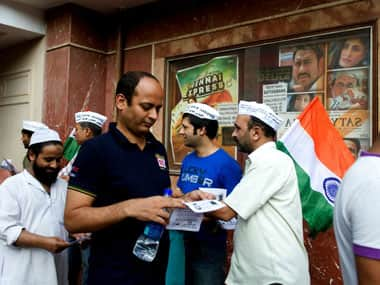The established political parties may right now be battering the new kid on the block, the Aam Aadmi Party, but that hasn’t stopped them from drawing some lessons from the newbie. So it’s now fashionable to have their cadres sport white caps with some slogans, one of the several AAP methods others are mimicking. For instance, the Congress has said – a point reiterated by Rahul Gandhi in his first ever interview – it will choose 15 of its Lok Sabha election candidates through a method that is bottom-up instead of party top brass leaders imposing one on the electorate. Even this, for this mighty party, will be a test run. The BJP has said its anti-AAP campaign for non-fulfillment of promises which it would undertake sooner or later, will be on the basis of what the people tell them are the issues – a referendum, something they had mocked when AAP used it to ask if it should form the government or not. The Congress will also hold constituency-level referendums to decide on continuance of support, whenever the political need arises for them to take that call. [caption id=“attachment_133995” align=“alignleft” width=“380”]  A file photo of the AAP’s election campaign in Delhi. Naresh Sharma / Firstpost[/caption] All these point to the merit of the methods of AAP that shocked the older parties with its glowing debut. These, apparently, are ways to tell the electorate that they too have become sensitive to public opinion and care for the voters, that their political decisions are not self-serving but people-centric. If that were so, why is it not possible to mimic the AAP’s campaign and keep expenses low, which is what we have been led to believe? It would be a new and thrilling reform because election costs are generally thrown at public moralists as the cause for corruption around party tickets to contest. The Election Commission has not been able to curb exorbitant spending. However, the Election Commission of India seems to think that low expenses are impossible, for, as The Indian Express reported, it plans to hike the election expense limits by up to 50 per cent. Inflation is cited as the reason. Candidates often complain of increasing costs. The moment the communication goes from it, the government would oblige by notifying new levels. In 2009, the Assembly campaign expense limit was hiked and fixed at Rs 16 lakh and for Lok Sabha, Rs 40 lakh per candidate. If the constituency size is smaller, the bar goes down. An MP aspirant in a geographically smaller constituency is expected to wind up his campaign by spending what a candidate in a bigger Assembly constituency was allowed. By now, all candidates who fought the Delhi Assembly elections would have sent in their statements of expenditure incurred for their respective campaigns. They are bound to within 30 days of getting elected and list all expenses incurred from the day of nomination to the election. If they fail, they risk the wrath of the law and face disqualification from contesting for three years. It would have been clear already in one measure or the other, at least roughly, as to how much each spent, even if the actual examination had not been conducted by the Election Commission officials. It would have an idea whether the Aam Aami Party candidates managed to remain within the limit – Rs 14 lakh per constituency. The AAP, in the midst of the campaigning, had asked donors to stop sending in cheques because they had received more money than they needed. From the claims made, AAP did not appear to have spent as other party candidates generally do. In short, they managed their budgets well. This, however, has already come up for test. An election petition has been filed in the Delhi High Court against Arvind Kejriwal and Somnath Bharati, and one more, accusing them of corrupt practices which in this case is allegedly understating their expenses. It appears, according to the petition, they held a musical event and attended it. The costs were not included in the submissions to the EC. These, as of now, are only contentions of the petitioners, and would take a long-winded judicial procedure to determine if the AAP candidates had indulged in corrupt practices. The anecdotal evidence on a general level is that AAP spent much less or only up to the prescribed limits. What then is the need for the ECI to raise the bar when it is an opportunity to put the fear of God and law in contestants to the Lok Sabha and ask them to spend judiciously? These hikes, however, have little meaning. Many candidates spend in multiples of the prescribed levels. Creative accounting and black money helps do that. The ECI could wait till the Lok Sabha elections are over and see if candidates across the country manage to curb their expenses instead of splurging. When they splurge, there are no limits. ECI knows that, and has not managed to enforce the rule effectively. Since the hike would anyhow be an anodyne to the big spenders, what is the hurry?
If AAP candidates spent below their allowed limits for the Assembly elections, other candidates can follow suit in the Lok Sabha elections.
Advertisement
End of Article
Written by Mahesh Vijapurkar
Mahesh Vijapurkar likes to take a worm’s eye-view of issues – that is, from the common man’s perspective. He was a journalist with The Indian Express and then The Hindu and now potters around with human development and urban issues. see more


)
)
)
)
)
)
)
)
)



